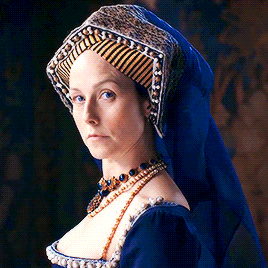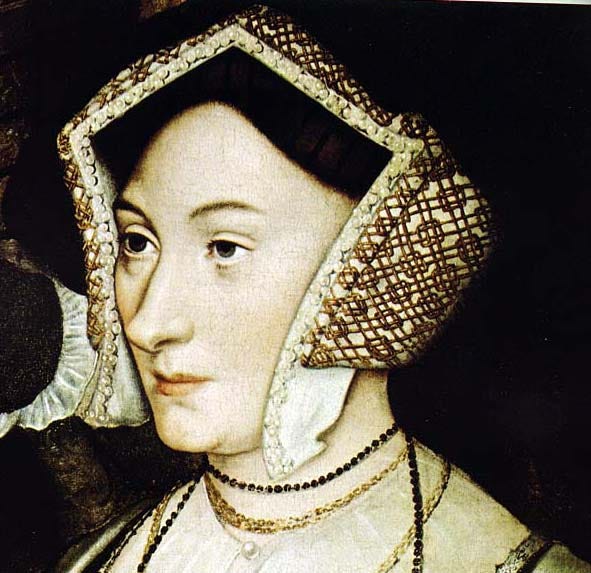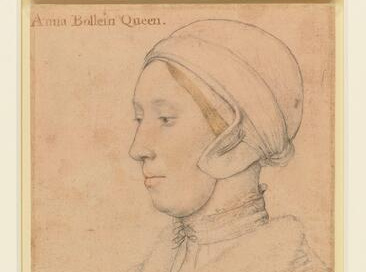
“Supremacy” is the domain of our reading this week. We encounter a few references to headgear, all of whose histories we have previously explored. As you may have noticed, I’ve taken a twofold approach to these posts:
If we encounter a new type of headgear or head covering, I research its origins and use in the Tudor era, sharing my findings as well as quotations from the novel(s).
If we’ve learned that history before, I explore the literary side of the textual reference. I was an English major in college and taught language arts & literacy analysis for almost a decade, and I enjoy exercising those muscles again!
Thank you for coming along for the ride! Now, let’s tuck in.
Our first reference isn’t to a piece of headgear, but rather to the head underneath the hood: specifically, Anne Boleyn’s famous (infamous?) head.
Even he can see her beauty, now she is queen. Her face seems scuplted in the purity of its lines, her skull small like a cat’s; her throat has a mineral glitter, as if it were powdered with fool’s gold. (541)
There are so many layers to this brief passage. First, I’m intrigued by how Cromwell’s view of Anne’s beauty is tied to her position as queen. Not being noble-born, Crumb stands apart from the layers and nuances of aristocratic hierarchy, which gives him a level of removal from the court’s iron-tight strictures. Henry tells him that Norfolk claims Cromwell even rejoices in the inferiority of his connections1.
And yet, his ever-increasing proximity to power just might be seducing him a little.
And yet! Anne’s glitter might just be fool’s gold.
I also love the feline imagery around Anne. For now, she is sleek and self-possessed. No longer tugging at her beads or fidgeting with fraught nerves, she is still and stately.
Next, we see baby Elizabeth again.
Ginger bristles poke from beneath her cap…. She pinches up the child’s cap at the hairline, and her fingers work busily, trying to stuff the bristles out of sight. (552)
The infant princess is once again mainly described by her oh-so-Tudor-y red hair, which seems to have a mind of its own. It has sprung free of its cap, despite the best efforts of Lady Bryan and Lady Shelton. There is pinching, stuffing, and hiding in an attempt to secret these little auburn tresses away.
I find this so interesting from two perspectives. First, the historical: It’s as if her hair is being swaddled and hidden away, the same way a Tudor women’s hair was often tucked and teased into submission below a cap and/or hood. Even an infant girl is brought into the fold of womanly modesty. Yet, also knowing the “spoiler alert” of Anne’s eventual fate, it’s still a bit sad to see this feature so hidden away, when it is her most obviously Tudor trait.
We return to Helen Barre through the lens of Rafe’s confession. We now know — gasp! — that “the fortunate Rafe” and “the beautiful Helen” are wed. Cromwell recalls the night he took Helen to meet Cranmer’s secret wife and looking for signs he may have missed. Surprising, for the man who never misses a trick.
“That evening … she came down without her cap, and you after, with your hair sticking up, and you were angry with me for taking her away…”
His hand creeps up and he flattens his hair with his palm, as if that would help matters now. (573)
Both Rafe and Helen are without head covering on that fateful evening, an oblique indication of the intimacy they share. Rafe’s cap, missing that night and missing in his conversation with Cromwell now, would have been one of many ways his status and profession would have been made known to the world. As Ruth Goodman explains in “How to Be a Tudor”:
Clothes formed a perfect universal vehicle for expression of [social function], even the humble cap…. By your cap alone a person could tell if you were a doctor, lawyer, or countryman, a fool (with bells on), a sailor in a shaggy thrum cap, a churchman, or if you followed a trade.’
Rafe’s hair sticking up brings us back to his first night at Austin Friars, as well. “Heaven help me: Boy or hedgehog?”

Finally, the contrast of connotations re: gable hoods vs. French hoods is prominent in “Supremacy.” Lady Mary the King’s daughter and Meg Roper both wear the older style, and both women have their reasons for aligning with older traditions of faith. Of queenship. Of femininity and womanhood.
First, the Lady Mary:
…She still wears an old-style gable hood, and she seems to blink around it, like a horse whose headcloth has slipped. (556)
And then, Margaret Roper:
Another face bowed under the weight of a gable hood: Meg twitches her veils about her, as if she were out in a gale and they would provide protection. (577)
The comparison between them is layered and apt. Both women have a beloved parent set directly against the desires of a tempestuous Henry VIII. Queen Katherine will not submit to being replaced; More will not submit his morals to take the oath of supremacy. Their daughters, each made in their image and each being one of their beleagured parent’s greatest sources of pride, wear the daily armor of a gable hood as both ideological statement and a form of protection. Others — namely men in power — cannot critique them when they visually connect themselves with humility, hiding beneath their hoods.
And for both young women, their parent seems hell-bent on self-destruction in the face of an implacable king.
Until next time.
Yours in ginger bristles and feline features,
Analise





![Sir Ralph Sadler (1507-1587) [Sadleir, Sadleyer] Sir Ralph Sadler (1507-1587) [Sadleir, Sadleyer]](https://substackcdn.com/image/fetch/$s_!ZwsN!,w_1456,c_limit,f_auto,q_auto:good,fl_progressive:steep/https%3A%2F%2Fsubstack-post-media.s3.amazonaws.com%2Fpublic%2Fimages%2Fd8ebf7be-eece-4050-a549-b8b130b03976_1912x1872.jpeg)
Another very intriguing post- thank you. I have some questions: the supposed Holbein sketch of Anne Boleyn appears to depict a woman with light-coloured hair, yet most descriptions of Anne imply that she was a brunette. The woman in the sketch also looks very demure: not a quality one might associate with Anne, at least as Mantel represents her: however, we do know that, after her marriage, Anne became much more ‘proper’ and regal in her behaviour, so maybe that is represented here? As we know from Shakespeare’s sonnets about ‘the Dark Lady’, dark haired women at the time were normally considered not to be beauties, at least in the English context and, at least as far as Shakespeare’s Lady is concerned, have something unhealthy about their sexual magnetism: I wonder whether this might be another reason why Anne was regarded so negatively, or whether it was Anne herself whose appearance later affected people’s perceptions of dark haired, sallow ladies? With regard to Elizabeth, and her ginger hair: again, what was the prevailing attitude, in terms of hair-colour, to women of roseate tint? Did red hair become more fashionable after her accession? Finally, Anne’s French Hood opens up the woman’s face clearly, so its expressions may be seen by everyone, whereas the Gable Hood is much more concealing of the face: I guess, in a modern context, the French Hood might be regarded as a Feminist statement. What do you think?